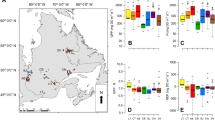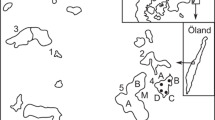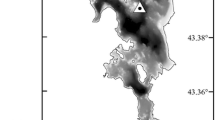Abstract
We characterized spatial and temporal variability in net ecosystem production (NEP), community respiration (CR), and gross primary production (GPP) over an ice-free season in an oligotrophic high-elevation lake using high-frequency measurements of dissolved oxygen. We combined the use of free-water and incubation chamber measurements to compare pelagic and benthic habitats and estimate their relative contributions to whole-lake metabolism. Despite a brief period of predominant heterotrophy after snowmelt, both free-water and incubation chamber measurements confirmed autotrophy of the epilimnion in all habitats throughout the ice-free season. In contrast, benthic incubation chambers showed the benthos to be consistently heterotrophic. Although temperature was the strongest seasonal driver of benthic metabolism, bacterioplankton density and indexes of organic matter quality explained the most variability in pelagic metabolism. Driven largely by benthic metabolism, free-water measurements of GPP and CR were twice as high in littoral than pelagic habitats. However, rates of water column primary production overlying the littoral benthos were high enough to overcome net benthic heterotrophy, and seasonal mean NEP in littoral habitats remained positive and not significantly different from pelagic habitats. Benthic rates averaged about 25% of whole-lake metabolism. Pelagic metabolism measurements were affected by littoral rates about half the time, with the degree of isolation between the two a function of advection and water column stability. These results emphasize the importance of characterizing spatial and temporal variability in metabolism within the context of physical dynamics and challenge the notion that benthic metabolism will necessarily be larger than pelagic metabolism in oligotrophic lakes.







Similar content being viewed by others
References
Aberg J, Jansson M, Karlsson J, Naas KJ, Jonsson A. 2007. Pelagic and benthic net production of dissolved inorganic carbon in an unproductive subarctic lake. Freshw Biol 52:549–60.
Admiraal W. 1977. Influence of light and temperature on growth-rate of estuarine benthic diatoms in culture. Mar Biol 39:1–9.
Andersen JM, Sand-Jensen K. 1980. Discrepancies between the O2 and 14C methods for measuring phytoplankton gross photosynthesis at low light levels. Oikos 35:359–64.
Andersson E, Brunberg AK. 2006. Net autotrophy in an oligotrophic lake rich in dissolved organic carbon and with high benthic primary production. Aquat Microb Ecol 43:1–10.
Ask J, Karlsson J, Persson L, Ask P, Bystrom P, Jansson M. 2009. Whole-lake estimates of carbon flux through algae and bacteria in benthic and pelagic habitats of clear-water lakes. Ecology 90:1923–32.
Barsdate RJ, Alexander V. 1971. Geochemistry and primary productivity of the Tangle Lake system and Alaskan alpine watershed. Arct Alp Res 3:27–41.
Biddanda B, Ogdahl M, Cotner J. 2001. Dominance of bacterial metabolism in oligotrophic relative to eutrophic waters. Limnol Oceanogr 46:730–9.
Brainerd KE, Gregg MC. 1995. Surface mixed and mixing layer depths. Deep Sea Res Part I 42:1521–43.
Borsheim KY, Andersen S. 1987. Grazing and food size selection by crustacean zooplankton compared to production of bacteria and phytoplankton in a shallow Norwegian mountain lake. J Plankton Res 9:367–79.
Carignan R, Blais AM, Vis C. 1998. Measurement of primary production and community respiration in oligotrophic lakes using the Winkler method. Can J Fish Aquat Sci 55:1078–84.
Carignan R, D’arcy P, Lamontagne S. 2000. Comparative impacts of fire and forest harvesting on water quality in Boreal Shield lakes. Can J Fish Aquat Sci 57:105–17.
Cole JJ, Caraco NF, Kling GW, Kratz TK. 1994. Carbon dioxide supersaturation in the surface waters of lakes. Science 265:1568–70.
Cole JJ, Caraco NF. 1998. Atmospheric exchange of carbon dioxide in a low-wind oligotrophic lake measured by the addition of SF6. Limnol Oceanogr 43:647–56.
Cole JJ, Pace ML, Carpenter SR, Kitchell JF. 2000. Persistence of net heterotrophy in lakes during nutrient addition and food web manipulations. Limnol Oceanogr 45:1718–30.
Cotner JB, Biddanda BA. 2002. Small players, large role: microbial influence on biogeochemical processes in pelagic aquatic ecosystems. Ecosystems 5:105–21.
del Giorgio PA, Peters RH. 1993. Balance between phytoplankton production and respiration in lakes. Can J Aquat Sci 50:282–9.
del Giorgio PA, Peters RH. 1994. Patterns in planktonic P-R ratios in lakes—influence of lake trophy and dissolved organic-carbon. Limnol Oceanogr 39:772–87.
del Giorgio PA, Cole JJ, Cimbleris A. 1997. Respiration rates in bacteria exceed phytoplankton production in unproductive aquatic systems. Nature 385:148–51.
del Giorgio PA, Cole JJ. 1998. Bacterial growth efficiency in natural aquatic systems. Annu Rev Ecol Syst 29:503–41.
del Giorgio PA, Cole JJ, Caraco NF, Peters RH. 1999. Linking planktonic biomass and metabolism to net gas fluxes in northern temperate lakes. Ecology 80:1422–31.
den Heyer C, Kalff J. 1998. Organic matter mineralization rates in sediments: a within- and among-lake study. Limnol Oceanogr 43:695–705.
Dodds WK, Cole JJ. 2007. Expanding the concept of trophic state in aquatic ecosystems: it’s not just the autotrophs. Aquat Sci 69:427–39.
Duarte CM, Agusti S. 1998. The CO2 balance of unproductive aquatic ecosystems. Science 281:234–6.
Duarte CM, Agusti S, Vaque D. 2004. Controls on planktonic metabolism in the Bay of Blanes, northwestern Mediterranean littoral. Limnol Oceanogr 49:2162–70.
Duarte CM, Prairie YT. 2005. Prevalence of heterotrophy and atmospheric CO2 emissions from aquatic ecosystems. Ecosystems 8:862–70.
Ducklow HW, Purdie DA, Williams PJL, Davies JM. 1986. Bacterioplankton: a sink for carbon in a coastal marine plankton community. Science 232:865–7.
Forget MH, Carignan R, Hudon C. 2009. Influence of diel cycles of respiration, chlorophyll, and photosynthetic parameters on the summer metabolic balance of temperate lakes and rivers. Can J Fish Aquat Sci 66:1048–58.
Goldman JC, Caron DA, Dennett MR. 1987. Regulation of gross growth efficiency and ammonium regeneration in bacteria by substrate C–N ratio. Limnol Oceanogr 32:1239–52.
Goldman CR, Jassby A, Powell T. 1989. Interannual fluctuations in primary production—meteorological forcing at two subalpine lakes. Limnol Oceanogr 34:310–23.
Hanson PC, Bade DL, Carpenter SR, Kratz TK. 2003. Lake metabolism: relationships with dissolved organic carbon and phosphorus. Limnol Oceanogr 48:1112–19.
Hicks BB. 1975. A procedure for the formulation of bulk transfer coefficients over water. Boundary-layer Meteorol 8:515–24.
Huettel M, Gust G. 1992. Solute release mechanisms from confined sediment cores in stirred benthic chambers and flume flows. Marine Ecol Prog Ser 82:187–97.
Idso SB. 1973. Concept of lake stability. Limnol Oceanogr 18:681–3.
Jahne B, Munnich KO, Bosinger R, Dutzi A, Huber W, Libner P. 1987. On the parameters influencing air-water gas-exchange. J Geophys Res Oceans 92:1937–49.
Jansson M, Bergstrom A, Blomqvist P, Drakare S. 2000. Allochthonous organic carbon and phytoplankton/bacterioplankton relationships in lakes. Ecology 8:3250–5.
Jassby A, Powell T. 1975. Vertical patterns of eddy diffusion during stratification in Castle Lake, California. Limnol Oceanogr 20:530–43.
Kemp WM, Smith EM, Marvindipasquale M, Boynton WR. 1997. Organic carbon balance and net ecosystem metabolism in Chesapeake Bay. Marine Ecol Prog Ser 150:229–48.
Kritzberg ES, Langenheder S, Lindstrom ES. 2006. Influence of dissolved organic matter source on lake bacterioplankton structure and function—implications for seasonal dynamics of community composition. Fems Microbiol Ecol 56:406–17.
Lauster GH, Hanson PC, Kratz TK. 2006. Gross primary production and respiration differences among littoral and pelagic habitats in northern Wisconsin lakes. Can J Fish Aquat Sci 63:1130–41.
MacIntyre S, Melack JM. 1995. Vertical and horizontal transport in lakes: linking littoral, benthic, and pelagic habitats. J North Am Benthol Soc 14:599–615.
MacIntyre S, Romero JR, Kling GW. 2002. Spatial-temporal variability in surface layer deepening and lateral advection in an embayment of Lake Victoria, East Africa. Limnol Oceanogr 47:656–71.
MacIntyre S, Fram JP, Kushner PJ, Bettex ND, O’brien WJ, Hobbie JE, Kling GW. 2009. Climate-related variations in mixing dynamics in an Alaskan arctic lake. Limnol Oceanogr 54:2401–17.
MacIntyre S, Jonsson AJ, Jansson M, Aberg J, Turney D, Miller S. 2010. Buoyancy flux, turbulence, and the gas transfer coefficient in a stratified lake. Geophys Res Lett 37:L24604-1–L24604-5.
Mcknight DM, Boyer EW, Westerhoff PK, Doran PT, Kulbe T, Andersen DT. 2001. Spectrofluorometric characterization of dissolved organic matter for indication of precursor organic material and aromaticity. Limnol Oceanogr 46:38–48.
Melack JM. 1982. Photosynthetic activity and respiration in an equatorial African soda lake. Freshw Biol 12:381–99.
Melack JM, Cooper SD, Holmes RW. 1987. Chemical and biological survey of lakes and streams located in the Emerald Lake watershed, Sequoia National Park. Santa Barbara: California Air Resources Board and University of California. p 345.
Melack JM, Cooper SD, Jenkins TM. 1989. Chemical and biological characteristics of Emerald Lake and the streams in its watershed, and the responses of the lake and streams to acidic deposition. Santa Barbara: California Air Resources Board and University of California. p 377.
Melack JM, Stoddard JL. 1991. Sierra Nevada. In: Charles DF, Ed. Acidic deposition and aquatic ecosystems: regional case studies. Berlin: Springer-Verlag. p 503–30.
Millero FJ, Poisson A. 1981. International one-atmosphere equation of state of seawater. Deep Sea Res Part A 28:625–9.
Monismith SG, Imberger J, Morison ML. 1990. Convective motions in the sidearm of a small reservoir. Limnol Oceanogr 35:1676–702.
Nelson CE. 2008. The phenology, biogeography, and metabolism of bacteria in high-elevation lakes of the Sierra Nevada, California. Ph.D. thesis, University of California, Santa Barbara.
Nelson CE. 2009. Phenology of high-elevation pelagic bacteria: the roles of meteorologic variability, catchment inputs and thermal stratification in structuring communities. ISME J 3:13–30.
Nelson CE, Sadro S, Melack JM. 2009. Contrasting the influences of stream inputs and landscape position on bacterioplankton community structure and dissolved organic matter composition in high-elevation lake chains. Limnol Oceanogr 54:1292–305.
Odum HT. 1956. Primary production in flowing waters. Limnol Oceanogr 1:102–17.
Perez MT, Sommaruga R. 2006. Differential effect of algal- and soil derived dissolved organic matter on alpine lake bacterial community composition and activity. Limnol Oceanogr 51:2527–37.
Pomeroy LR. 1974. The ocean’s food web, a changing paradigm. Bioscience 24:499–504.
Prairie YT, Bird DF, Cole JJ. 2002. The summer metabolic balance in the epilimnion of southeastern Quebec lakes. Limnol Oceanogr 47:316–21.
Sadro S, Nelson CE, Melack JM. 2011. Linking diel patterns in community respiration to bacterioplankton in an oligotrophic high-elevation lake. Limnol Oceanogr 56:540–50.
Sadro S, Melack JM, MacIntyre S. 2011. Depth-integrated estimates of ecosystem metabolism in a high-elevation lake (Emerald Lake, Sierra Nevada, California). Limnol Oceanogr.
Sand-Jensen K, Borum J. 1991. Interactions among phytoplankton, periphyton, and macrophytes in temperate fresh-waters and estuaries. Aquat Bot 41:137–75.
Shay TJ, Gregg MC. 1986. Convectively driven turbulent mixing in the upper ocean. J Phys Oceanogr 16:1777–98.
Sickman JO, Melack JM. 1992. Photosynthetic activity of phytoplankton in a high-altitude lake (Emerald Lake, Sierra-Nevada, California). Hydrobiologia 230:37–48.
Sickman JO, Melack JM, Clow DW. 2003. Evidence for nutrient enrichment of high-elevation lakes in the Sierra Nevada, California. Limnol Oceanogr 48:1885–92.
Simon M, Cho BC, Azam F. 1992. Significance of bacterial biomass in lakes and the ocean—comparison to phytoplankton biomass and biogeochemical implications. Marine Ecol Prog Ser 86:103–10.
Smith SD. 1988. Coefficients for sea surface wind stress, heat flux, and wind profiles as a function of wind speed and temperature. J Geophys Res 93:15467–72.
Staehr PA, Sand-Jensen K. 2007. Temporal dynamics and regulation of lake metabolism. Limnol Oceanogr 52:108–20.
Staehr PA, Bade D, Van de Bogert MC, Koch GR, Williamson C, Hanson P, Cole JJ, Kratz T. 2010. Lake metabolism and the diel oxygen technique: state of the science. Limnol Oceanogr Methods 8:628–44.
Staehr PA, Testa JM, Kemp WM, Cole JJ, Sand-Jensen K, Smith SV. 2011. The metabolism of aquatic ecosystems: history, applications, and future challenges. Aquat Sci. DOI:10.1007/s00027-011-0199-2.
Vadeboncoeur Y, Steinman AD. 2002. Periphyton function in lake ecosystems. Sci World J 2:1–20.
Vadeboncoeur Y, Jeppesen E, Vander Zanden MJ, Schierup H, Christoffersen K, Lodge DM. 2003. From Greenland to green lakes: cultural eutrophication and the loss of benthic pathways in lakes. Limnol Oceanogr 48:1408–18.
Vadeboncoeur Y, Peterson G, Vander Zanden MJ, Kalff J. 2008. Benthic algal production across lake size gradients: interactions among morphometry, nutrients, and light. Ecology 89:2542–52.
Van De Bogert MC, Carpenter SR, Cole JJ, Pace ML. 2007. Assessing pelagic and benthic metabolism using free water measurements. Limnol Oceanogr Methods 5:145–55.
Vander Zanden MJ, Chandra S, Park SK, Vadeboncoeur Y, Goldman CR. 2006. Efficiencies of benthic and pelagic trophic pathways in a subalpine lake. Can J Fish Aquat Sci 63:2608–20.
Acknowledgments
We thank Kevin Skeen for field assistance. Sequoia-Kings Canyon National Park provided administrative support of for this research. Financial support was provided by the National Science Foundation (NSF) through the Graduate Research Fellowship Program (to SS) and through Division of Environmental Biology awards 0614207 (to JMM) and 0640953 (to SM). The comments of Craig Nelson, Michael Pace, and two anonymous reviewers helped improve this manuscript.
Author information
Authors and Affiliations
Corresponding author
Additional information
Author Contributions
Sadro conceived the study, performed the research, analyzed the data, contributed models used in the analysis, and wrote the MS; Melack contributed to the study design, contributed to the methods, and edited the MS; MacIntyre contributed models used in the analysis and edited the MS.
Rights and permissions
About this article
Cite this article
Sadro, S., Melack, J.M. & MacIntyre, S. Spatial and Temporal Variability in the Ecosystem Metabolism of a High-elevation Lake: Integrating Benthic and Pelagic Habitats. Ecosystems 14, 1123–1140 (2011). https://doi.org/10.1007/s10021-011-9471-5
Received:
Accepted:
Published:
Issue Date:
DOI: https://doi.org/10.1007/s10021-011-9471-5




